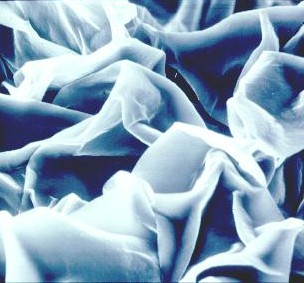
A small meteor crashes down in a farmer's field. A group of people go to retrieve the space rock, but find a high tech box inscribed with heiroglyphics in its place. They open the box and discover several samples of pasty substance, each with a different hue--light green, beige, blue, etc.--but all with the consistency of peanut butter.
Scientists take this alien gift and carefully examine it under a microscope. They are deeply impressed by what they see. "Highly sophisticated bio-engineering," they declare.
The micro-structure contains three layers, the first having a crystalline structure like salt or diamond. Clinging to this like a magnet is a mesh of minerals, including potassium. And to top it off, a sprinkle of organic molecules, each sample containing combinations as unique as snowflakes in terms of type and arrangement of these molecules. "Only a super-intelligent race could have created this," announce the stunned scientists.
But what does it do?
After running a 1000 different tests on it, they discover it kills bacteria. Not just any bacteria but the super-bugs like MRSA, the one stalking hospitals, schools and other public places, causing ugly pus-leaking sores, and resistent of most antibiotics doctors throw at it.
The people of the Earth rejoice. Yet, questions remain. The scientists can see what it looks like, but can't quite figure out how the substance is doing the bacteria-fighting. And they can only guess how the brilliant alien race managed to sythesize such a complex compound.
Well, the substance I've just described is actually simple old clay, not a high-tech concoction derived from ET. It's been used since Roman times for treating nausea and cuts and after years of getting the cold shoulder from modern medicine (because of "lack of research") it is now getting the respect it deserves.
Indeed, it's shown encouraging results against highly drug-resistant strains like MRSA and a flesh eating bacteria called "Buruli ulcer" that has ravaged parts of Africa. But just as descibed in my little story, scientists don't know what the clay is actually doing. Some of those unique organic molecules could be poisonous to the bacteria. Maybe it has somrthing to do with it's acidity...
No one knows.
But the real question is will the medical community in Canada and the US will embrace the novel idea of using simple clay to treat disease? Or will they hide behind medical orthodoxy and dismiss clay as just a fringe therapy, not worthy of serious attention?
---
Picture: a micrograph of clay, from this site.
Monday, April 7, 2008
Clay To Keep the Doctor Away
Subscribe to:
Post Comments (Atom)



No comments:
Post a Comment